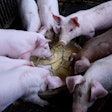
Indonesia has confirmed its first ASF outbreaks, South Korea and Russia report more cases in wild boar and further consequences of the disease are being felt in China and the Philippines
In South Korea, the number of wild boar that have tested positive for the African swine fever (ASF) virus has reached 43. The disease was first detected in the country on September 17. All outbreaks since then have been in the area bordering the Democratic People’s Republic of Korea (North Korea), where the progress of the disease is unreported.
Two wild boar carcasses have tested positive for ASF in the past few days, reports Yonhap news agency. Both were found in the Yeoncheon district of Gyeonggi province. No new cases have been reported in domestic pigs in South Korea for several weeks, but the number of animals culled to control the spread of the disease stands at almost 400,000.
This week, the country’s agriculture ministry reported five new cases among wild boar to the World Organisation for Animal Health (OIE). One animal had been shot, while the others were found dead. Three of these cases were in the Paju city region in Gyeonggi, and the other two were in the Cheorwan region of Gangwon. Both provinces border North Korea.
South Korea has so far received no response from North Korea after repeated offers to assist in the control of ASF. Yonhap reports this week that the unification ministry in Seoul handling inter-Korean affairs is preparing to provide support to its northern neighbor in fighting the disease through international agencies or non-governmental organizations.
More ASF cases in Russia’s Far East
The agriculture ministry has reported to the OIE a further 20 cases of ASF among the wild boar population in its Far Eastern federal district. Found during the first week of December, these included 18 animals in Amur oblast, and two in Yevreyskaya (Jewish Autonomous oblast).
The most recent outbreak among domestic pigs in the region was in a backyard herd on November 6.
ASF confirmed in Indonesia
The Ministry of Agriculture has confirmed that ASF has been detected in North Sumatra province, reports the United Nations’ Food and Agriculture Organization (FAO). Scale of the outbreaks is unclear, but elevated mortality of pigs in the area has been reported since September.
Indonesia is the 12th country in Asia to have reported ASF outbreaks this year (including Russia’s Far East region).
ASF in China impacts insurance sector
As well as the direct effects of ASF on China’s pig population, indirect impacts of the disease are beginning to emerge.
Latest to be taking a hit is the Chinese insurance sector, according to Caixin Global. Insurance companies have been paying out more after ASF outbreaks than they have collected. The firms are now reported to be paying out CNY130 (US$18.64) for every CNY100 (US$14.34) paid in premiums. Before the outbreaks started, the loss ratio was 50-60%, so they were paying out CNY50-60 for every CNY100 collected.
The same source puts losses to ASF at about one-third of China’s pigs, costing an estimated US$140 billion in direct losses. Local analysts expect pork production to be down by as much as 40% this year.
First cases of ASF in China were reported in August 2018. OIE figures put the number of outbreaks in China (including Hong Kong) at 167, with 35 still ongoing. Direct pig losses in these outbreaks stands at almost 383,000. Official Chinese reports of outbreaks to the OIE appear to represent only a proportion of the overall losses due to ASF.
Furthermore, the number of new outbreaks reported to the OIE has declined. Indeed, the agriculture ministry has announced recently that the decline in the national pig population has stopped. For the first time since the outbreaks started, a small increase has been registered in the number of breeding sows. The ministry said this was a sign of recovery in the commercial pig sector. It has also begun to implement regional disease prevention and control measures.
A global rise in pork prices this year has been attributed, at least in part, to ASF outbreaks in China.
China’s agriculture ministry has announced the first new cases of ASF for about one month. This week, three wild boar in the Hanzhong city region of Shaanxi province tested positive for the virus. The local government has initiated an emergency response to dispose of wild boar carcasses and sick animals, as well as to monitor and disinfect any domestic pigs kept nearby.
Zoning plan for the Philippines
Agriculture Secretary William Dar of the Philippines is reported to be drawing up zoning plans to gain control over ASF. The aim is to regulate the movement of pigs and pork products around the country, reports Inquirer.
Since the country’s first outbreak in Luzon, provincial governments across the rest of the country have imposed bans independently in order to protect their local pig farmers from the potentially devastating disease.
Following consultation with pig producers, Dar has proposed that the country is divided into five geographical zones with two broad categorizations — “free” or “contaminated.” “Free” zones have reported no cases of ASF, and can trade pigs and pork anywhere in the country.
“Contaminated” zones include four subzones — protected, surveillance, infected and buffer. Parts of Bulacan and Pampanga are infected zones where the disease is still spreading, and they can only trade pigs and pork with other infected areas. Other parts of these provinces are buffer zones.
For those areas of Central Luzon and Calabarzon with the highest density of commercial and backyard operations, pork and pig trade will be monitored by the national ASF task force.
The most recent case of ASF in the country was in Pangasinan on October 23, according to Inquirer. So far, the disease has been confirmed in seven provinces and cities, and almost 500 municipalities. A total of 136,770 pigs have been culled to prevent its further spread, although only 18% were later found to be infected.
Australia is to raise biosecurity funding to prevent the entry of ASF by AUD67 million (US$45 million).
View our continuing coverage of the African swine fever outbreak.

















